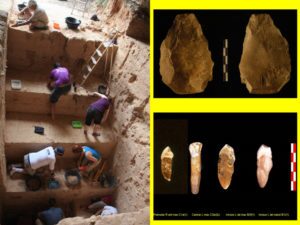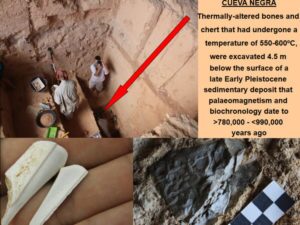
In a recently published paper* in the journal, Historical Biology, researchers report confirmation that sediments bearing early human cultural remains in the Cueva Negra del Estrecho del Río Quípar rockshelter in southeastern Spain are dated to over 800,000 years ago. The sediments include an Acheulean style stone handaxe and evidence for the use of fire within the rockshelter.
“We regard its age as quite likely between 865,000 and 810,000 years ago,” said Michael Walker of Spain’s Murcia University, a lead researcher on Cueva Negra.
“[Arguably] Until now hand-axes in Europe have not been recorded from before 500,000 years ago,” said Walker. Moreover, he adds, “the evidence of combustion [use of fire] is also the oldest anywhere outside Africa.”
The new dating results were acquired through biochronological analysis of small-mammal teeth remains found within the Cueva Negra rockshelter, indicating they accumulated during what is technically called the Matuyama magnetochron, or between 0.99 and 0.78 Ma.
Researchers do not yet know what species of ancient human occupied the rockshelter during this early time period, but they suggest that they were pre-Neanderthal, possibly Homo heidelbergensis, Homo antecessor, or Homo erectus. Homo erectus has been most often associated with Acheulean handaxes in the archaeological record, but there is no consensus or evidence that shows that this stone tool type was exclusive to Homo erectus.
The rock-shelter, located in the face of a cliff overlooking the Quipar river and the small village of La Encarnación, became the subject of initial exploration by archaeologists in 1981. But full systematic excavations didn’t begin until 1990, when an archaeological team led by Walker and colleagues with the Murcia University Experimental Sciences Research Group undertook detailed investigation that have continued for multiple field seasons. What they uncovered were 5 meters of sediment containing late Pleistocene (somewhat before 780,000 years ago) finds, including hominin (early human, possibly H. heidelbergensis) teeth, a rich artifact assemblage, and an array of ancient flora and fauna remains that bespoke an ancient climate of warm, moist environmental conditions. Their analysis and interpretation of the finds may have, they maintain, important implications for early human behavior.
“The most important findings at Cueva Negra concern human activity,” write Walker and colleagues in their report. “Undoubted evidence of fire has been uncovered.”** They point to the evidence of sediment combustion, thermally altered chert and burnt animal bone found in a layer measured at 4.5 meters in depth.
But they qualify their interpretation.
“A fire-place is not a hearth,” the authors continue. “The Cueva Negra could have brought glowing brands left by a forest fire into the cave to establish and tend a fire where rain and wind would not put it out. They may well have been less afraid of fire outside than other animals they saw fleeing from it (which could have led them to play with fire in order to drive animals towards natural death traps, such as swamps, enabling dismemberment and roasting). This does not mean they could reproduce or control fire: there is a dearth of archaeological evidence for hearths or fire-pits before 0.5 Ma.”
_____________________________

Cueva Negra with hand-axe and teeth. Courtesy Michael Walker, et. al.
________________________________

Cueva Negra deep layer with thermally altered remains. Courtesy Michael Walker, et. al.
________________________________
Cueva Negra is not the only site that has evidenced early use of fire by early humans. For example, the site of Bnot Ya’akov Bridge in Israel has been claimed to show human control of fire some time between 790,000 and 690,000 years ago, and evidence has emerged at Wonderwerk Cave in South Africa for the use of fire by around 1 million years ago. There are also other sites showing this possibility in Africa and China. But Cueva Negra could be the earliest, if not one of the earliest, sites in Europe demonstrating this development.
Other findings suggested a clear mastery of material resources for survival. The assemblage of stone tool artifacts recovered (classified by the authors as “Acheulo-Levalloiso-Mousteroid”) showed evidence of the use of three different core reduction methodologies or sequences, and that natural stone resources were exploited as much as 40 km downstream from the site and 30 km upstream.
Concludes Walker, et al., “Research at Cueva Negra throws new light, including fire-light, on the cognitive versatility, manual dexterity, and technical aptitude of early humans ca. [now earlier than] 0.8 Ma in S.E. Spain. They exploited their surroundings in a competent fashion that implies precise knowledge and accurate awareness of what was available for survival.”**
____________________________
*Antonio López Jiménez, María Haber Uriarte, Mariano López Martínez & Michael John Walker (2018): Small-mammal indicators of biochronology at Cueva Negra del Estrecho del Río Quípar (Caravaca de la Cruz, Murcia, SE Spain), Historical Biology, DOI: 10.1080/08912963.2018.1462804
**Walker, Michael, et al., The Early Humans of Cueva Negra, Popular Archaeology, Vol. 15, June, 2014.
____________________________
Join us on this extraordinary journey!
____________________________


